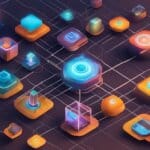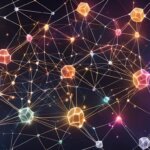Table of Contents
Welcome to the next generation of the internet – Web 3.0. Also known as the decentralized web, Web 3.0 aims to revolutionize the digital landscape by decentralizing control and empowering individuals. Through emerging technologies such as blockchain, decentralized networks, artificial intelligence, and the Internet of Things (IoT), Web 3.0 opens up exciting possibilities for a more equitable and user-centric online experience.
Web 3.0 features include decentralization, interoperability, enhanced privacy, smart contracts, and AI integration. These advancements pave the way for a digital ecosystem that prioritizes user empowerment, data ownership, and secure interactions. From decentralized finance (DeFi) platforms to non-fungible tokens (NFTs) and decentralized social media, Web 3.0 is already shaping industries and redefining the way we interact online.
However, as with any transformative technology, Web 3.0 faces challenges that need to be addressed. Complexity, scalability, and regulatory concerns require careful consideration for the full potential of Web 3.0 to be realized. Nevertheless, the ongoing development and real-world applications of Web 3.0 indicate a promising future filled with intelligent, decentralized, and personalized experiences.
What is Web 3.0?
Web 3.0, also known as the decentralized web, is the next phase of the internet’s evolution. It aims to distribute power and facilitate peer-to-peer interactions through technologies like blockchain, decentralized networks, artificial intelligence, and the Internet of Things (IoT). Web 3.0 differs from its predecessor, Web 2.0, by focusing on decentralization, user empowerment, and data ownership. It envisions a more open, secure, and user-centric digital ecosystem.
Web 3.0 is a paradigm shift that moves away from the centralized model of Web 2.0, where power is concentrated in the hands of a few large corporations. Instead, it empowers individuals and promotes a peer-to-peer economy. By leveraging blockchain technology, Web 3.0 ensures transparency, security, and trust in online transactions and interactions.
Web 3.0 aims to democratize the web, giving users more control over their data and online experiences.
With Web 3.0, users have ownership and control over their personal data, which is encrypted and protected from unauthorized access. This enhances privacy and mitigates concerns about data breaches and surveillance. Additionally, Web 3.0 enables seamless interoperability between various platforms and applications, allowing data and services to be shared across different networks.
Web 3.0 incorporates artificial intelligence to create personalized and intelligent experiences for users. AI algorithms can analyze vast amounts of data to provide tailored recommendations, automate tasks, and improve decision-making processes. This integration of AI enhances user convenience and efficiency in navigating the digital landscape.
As Web 3.0 continues to evolve, it holds the potential to revolutionize industries such as finance, social networking, Internet of Things (IoT), supply chain management, gaming, and virtual reality. By leveraging decentralized finance (DeFi), Web 3.0 offers financial services without intermediaries, granting users more financial autonomy. Decentralized social networking platforms put control back in users’ hands, enhancing privacy and reducing the influence of central authorities.
Web 3.0 enables secure and interconnected networks of smart devices in the IoT space, fostering a more efficient and intelligent infrastructure. In supply chain management, blockchain technology ensures transparency and traceability, minimizing fraud and counterfeiting risks. Additionally, Web 3.0 enhances gaming experiences and virtual reality environments by introducing ownership of in-game assets and empowering users to create and share content.
Key Features of Web 3.0
| Feature | Description |
|---|---|
| Decentralization | Eliminates single points of failure and enables peer-to-peer interactions. |
| Smart Contracts | Automates processes and ensures trust and transparency in transactions. |
| Interoperability | Allows different applications and platforms to communicate and share data. |
| Enhanced Privacy | Encrypts personal data and ensures user ownership and control. |
| AI Integration | Utilizes artificial intelligence for personalization, automation, and data analysis. |
Key Features of Web 3.0
Web 3.0 introduces a range of groundbreaking features that redefine the way we experience the internet. These features include:
- Decentralization: Web 3.0 aims to decentralize control and eliminate single points of failure. By utilizing blockchain technology, it enables peer-to-peer interactions, empowering individuals and promoting trust in digital transactions.
- Smart Contracts: With the integration of smart contracts, Web 3.0 automates processes and ensures transparency in a secure manner. Smart contracts are self-executing agreements that abide by predefined rules, enabling parties to interact directly without the need for intermediaries.
- Interoperability: Web 3.0 facilitates seamless communication and data exchange between different applications and platforms. This interoperability allows for the creation of connected digital ecosystems, enabling users to enjoy integrated experiences across multiple platforms.
- Enhanced Privacy: Privacy is a significant focus in Web 3.0, with measures such as encryption and user ownership of personal data. Users have greater control over their information, reducing the risk of unauthorized access and ensuring a more private online experience.
- AI Integration: Artificial intelligence is a key component of Web 3.0, enabling personalization, automation, and advanced data analysis. AI integration enhances the efficiency of digital services and provides tailored experiences based on user preferences and behaviors.
These features redefine the internet landscape, empowering individuals, promoting trust, and offering enhanced privacy. Web 3.0 opens up a world of possibilities, revolutionizing various industries and paving the way for a more decentralized and inclusive digital future.

Potential Applications of Web 3.0
Web 3.0, with its decentralized and user-centric approach, has the potential to revolutionize various industries by leveraging emerging technologies. Let’s explore some key applications of Web 3.0 in different sectors:
1. Decentralized Finance (DeFi)
Decentralized finance platforms powered by Web 3.0 enable financial transactions and services without intermediaries. By leveraging blockchain technology, DeFi eliminates the need for traditional financial institutions, allowing users to access lending, borrowing, and asset management services directly. This peer-to-peer approach offers greater financial inclusivity, transparency, and control over personal wealth.
2. Decentralized Social Networking
Web 3.0 introduces decentralized social networking platforms that prioritize user control, privacy, and data ownership. These platforms leverage blockchain technology to create decentralized networks where users have full control over their personal data. By excluding intermediaries and using consensus algorithms, Web 3.0 social networks aim to protect user privacy, eliminate targeted advertising, and empower individuals to choose how their data is shared.
3. Internet of Things (IoT) Integration
Web 3.0’s integration with the Internet of Things (IoT) enables a secure and interconnected network of smart devices. By leveraging blockchain technology, Web 3.0 ensures trust, security, and transparency in IoT interactions. This integration allows for seamless peer-to-peer communication between devices, facilitating tasks such as energy management, remote monitoring, and automated transactions. With Web 3.0 and IoT working together, personalized and efficient smart environments become a reality.
4. Supply Chain Management
Supply chain management stands to benefit from the transparency and traceability offered by Web 3.0 technologies. By leveraging blockchain, supply chain stakeholders can ensure the authenticity and provenance of goods, reduce fraud, and optimize logistics processes. Web 3.0 enables real-time tracking of goods, secure data sharing among stakeholders, and smart contracts for automated execution of agreements, fostering efficiency and accountability in supply chain operations.
5. Gaming and Virtual Reality
Web 3.0 enhances gaming experiences and virtual reality environments by introducing ownership of in-game assets and facilitating user-generated content. Through the use of blockchain technology, players can truly own and trade their virtual assets, creating a decentralized marketplace for digital collectibles. Additionally, Web 3.0 enables the creation of user-generated virtual worlds, fostering collaboration and creativity among gamers.
Challenges and the Future of Web 3.0
Web 3.0, with its immense potential, is not without its challenges. The complex technologies involved in its development pose hurdles that need to be overcome. The scalability issues in blockchain-based systems are a key concern, as they can impact the efficiency and performance of decentralized networks. Additionally, regulatory concerns around data privacy and security must be addressed to ensure a balanced approach that fosters innovation while protecting public interests.
Despite these challenges, the ongoing development and real-world applications of Web 3.0 point towards an exciting future. As the technology continues to evolve, individuals and businesses have the opportunity to adapt and explore the possibilities it brings. Web 3.0 represents a transformative reality that promises intelligent, decentralized, and personalized experiences.
The future of Web 3.0 is brimming with potential. It has the capability to revolutionize industries, enhance connectivity, and empower individuals. By addressing the complexities and scalability concerns, Web 3.0 can unlock new possibilities for decentralized finance, social networking, Internet of Things (IoT) integration, supply chain management, gaming, and virtual reality. As we embrace this future, it is crucial to stay informed and proactive in navigating the evolving landscape of Web 3.0.
FAQ
What is Web 3.0?
Web 3.0, also known as the decentralized web, is the next phase of the internet’s evolution. It aims to distribute power and facilitate peer-to-peer interactions through technologies like blockchain, decentralized networks, artificial intelligence, and the Internet of Things (IoT).
What are the key features of Web 3.0?
The key features of Web 3.0 include decentralization, smart contracts, interoperability, enhanced privacy, and AI integration. Decentralization enables peer-to-peer interactions and eliminates single points of failure. Smart contracts automate processes and ensure trust and transparency. Interoperability allows different applications and platforms to communicate and share data. Enhanced privacy is achieved through encryption and user ownership of personal data. AI integration plays a role in personalization, automation, and data analysis.
What are the potential applications of Web 3.0?
Web 3.0 has the potential to revolutionize various industries. Decentralized finance (DeFi) platforms provide financial services without intermediaries. Decentralized social networking platforms prioritize user control and privacy. Web 3.0 and IoT integration enable a secure and interconnected network of smart devices. Supply chain management can benefit from transparency and traceability through blockchain technology. Web 3.0 enhances gaming experiences and virtual reality environments by introducing ownership of in-game assets and facilitating user-generated content.
What are the challenges and the future of Web 3.0?
While Web 3.0 holds immense potential, it also faces challenges. Complex technologies, scalability issues in blockchain-based systems, and the need for regulatory frameworks that balance innovation and public interests are some of the challenges. However, the ongoing development and real-world applications of Web 3.0 indicate an exciting future. As it continues to evolve, individuals and businesses need to adapt and explore the opportunities it presents. Web 3.0 represents a transformative reality that promises intelligent, decentralized, and personalized experiences.







